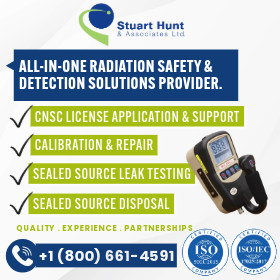Product Review: A Surveyor’s Best Friend—How a Handheld Isotope Identifier Can Solve Radiation Mysteries
Disclaimer
This review was written by the author in their personal capacity. The opinions expressed in this article are the author’s own and do not reflect the view of the Canadian Radiation Protection Association (CRPA).
CRPA solicits product reviews based on what we believe our readers would want to know. Our reviewers are volunteer contributors and we do not accept payment for product reviews.
Any reliance you place on the opinions expressed in this review is strictly at your own risk.
Background
Recently, at one of our local hospital sites, a sealed sharps container triggered the high alarm at one of our waste portal monitors.
The vast majority of unsealed waste (mostly shorter-lived diagnostic or therapeutic radioisotopes) exiting a building is initially held for delay and decay until it’s cleared at background, when negligible levels of radioactivity remain. The monitors are installed as a backup measure to detect any residual radioactive material that has the (infrequent) potential to escape.
Upon discovery, the sharps container was relocated to our secure underground waste room for further investigation. We had an outdated isotope identifier in need of a software update—testing showed very noisy spectra and it was difficult to identify peaks unless testing was done in a well-controlled experiment. Without adequate instrumentation available to readily assess and determine the suspect therapeutic radioisotope, other less scientific measures (i.e., brute force) were used to gain access to the vial and subsequently determine the cause of the alarm.
This incident confirmed for us that we needed to invest in a more suitable instrument to efficiently and accurately identify radioisotopes. We are both a research and patient-care institution with a cyclotron, and we see an ever-growing number of radioisotopes, often related to a number of new clinical trials, which substantiates the need for improved equipment.
RIIDEye X-G
The RIIDEye X-G (reminiscent of the proton pack from Ghostbusters) was selected as the portable multi-channel analyzer (MCA) of choice. Radiation isotope identifier devices (RIIDs) use spectroscopic analysis to identify radioactive isotopes.
The model we selected is equipped with a 2″ × 2″ sodium iodide (NaI) detector for spectroscopic radioisotope identification and has a patented algorithm for quick isotope identification. It’s very durable and lightweight, has an eight-hour battery life, and makes short work of identifying common isotopes in a variety of materials, including industrial, special nuclear, medical, and naturally occurring radioactive material (NORM).
Another important feature is the device’s ability to alert you if something is definitely present but may not match the currently available nuclei in its library. For those more challenging isotopes (such as unwanted radioisotope production by-products), the energy of the peaks can be manually identified on the identifier screen or after exporting the data and using computer software.
The detector doesn’t feature a touch screen, which leads to the tedious need to manually analyze peaks on the fly using only the instrument’s scroll buttons.
The data is exported as an .N42 file, which makes it complicated to import into standard corporate office software without using a separate file converter. The manufacturer does provide its own software, which can easily import the data and fit the peaks for those uncommon radioisotopes. We successfully used this method to characterize production waste from the cyclotron facility, to understand which radioisotopes were present, and to determine the best way to deal with the hazards they present and select a waste disposal method.
The RIIDEye X-G was also able to rapidly identify the next waste monitor flag, which was identified as Technetium-99m (99mTc) escaping via biological waste (a usual suspect).
Using the RIIDEye X-G can save time and money by eliminating the need to take swipe samples, send them off for analysis at an off-site lab, and wait for results.
So next time there’s unknown radioactive material discovered, who you gonna call?
Cost: CA$23,000.
(Note: An improved 1.5″ × 1.5″ lanthanum bromide model is also available, retailing for CA$65,000, which was a little rich for our blood.)
 |
 |
 |
Résumé : Évaluations de produits : Le meilleur ami de l’évaluateur ou comment résoudre de mystérieux rayonnements avec un identificateur d’isotopes radioactifs
Après le déclenchement d’une alarme à niveau élevé sur le moniteur de déchets portatif installé dans un hôpital, suivi d’une tentative complexe d’identification de la source de l’alarme avec un équipement désuet, l’équipe de Matthew Bernacci s’est procuré un nouvel identificateur d’isotopes radioactifs portable RIIDEye X-G. Dans cette évaluation de produit, Matthew partage les points forts de l’appareil et certaines de ces lacunes.
 Matthew Bernacci
Matthew Bernacci
Matthew Bernacci is a radiation safety specialist at University Health Network. He completed both his BSc in medical physics and his MSc in radiation sciences at McMaster University. He has completed part 1 of the Certified Health Physicist exam and is part of the CRPA Students and Young Professionals Committee (SYPCOM). His work experience has focused on radiation safety instrumentation, inspections, and clinical trials.
Do you want to read more articles like this?
The Bulletin is published by the Canadian Radiation Protection Association (CRPA). It’s a must-read publication for radiation protection professionals in Canada. The editorial content delivers the insights, information, advice, and valuable solutions that radiation protection professionals need to stay at the forefront of their profession.
Sign up today and we’ll send you an email each time a new edition goes live. In between issues, check back often for updates and new articles.
Don’t miss an issue. Subscribe now!
Subscribe

 Matthew Bernacci
Matthew Bernacci

